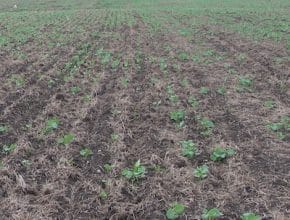If soil conditions are dry and seed hasn’t imbibed water to start the germination process, there won’t have been enough water for the seed treatment to do anything but stay on the seed coat. Seed will still be viable and as soon as it rains, the clock starts ticking on seed treatment…
May 30, 2018 - Issue 9
-
-
The key with a thin stand is to do what it takes to protect those plants. A stand needs a minimum of 4-5 plants per square foot to have the best chance to reach its yield potential. For a canola field at or below that plant population, consider lowering the action thresholds for insect, weed and disease management all season…
-
See bare patches like this? Could be cutworms. Include cutworms on the scouting checklist for the first one to three weeks after emergence. Any later and management becomes more difficult because (i) spraying a registered insecticide is useless because the cutworms have developed beyond the feeding stage, and/or (ii) reseeding options are starting to be limited…
-
Canola harvested last fall and still in on-farm storage can be at risk from heating. Hot outside weather will restart moisture movement within a bin, and if the canola has other risk factors – such as higher moisture and/or dockage – that concentrated moisture could lead to heating…
-
Time management, weather, family and economic stresses can pop up often for farmers. Stress can be a big factor in mental health. Contact these help centres for any mental health concerns. British Columbia: CRISIS Centre BC, 24-hour support. Phone 310-6789 Alberta: Mental Health Hotline, 24-hour support. Phone 1-877-303-2642 Saskatchewan: Farm Stress Line. Phone: 1-800-667-4442 Manitoba: Manitoba Farm, Rural Support &…

